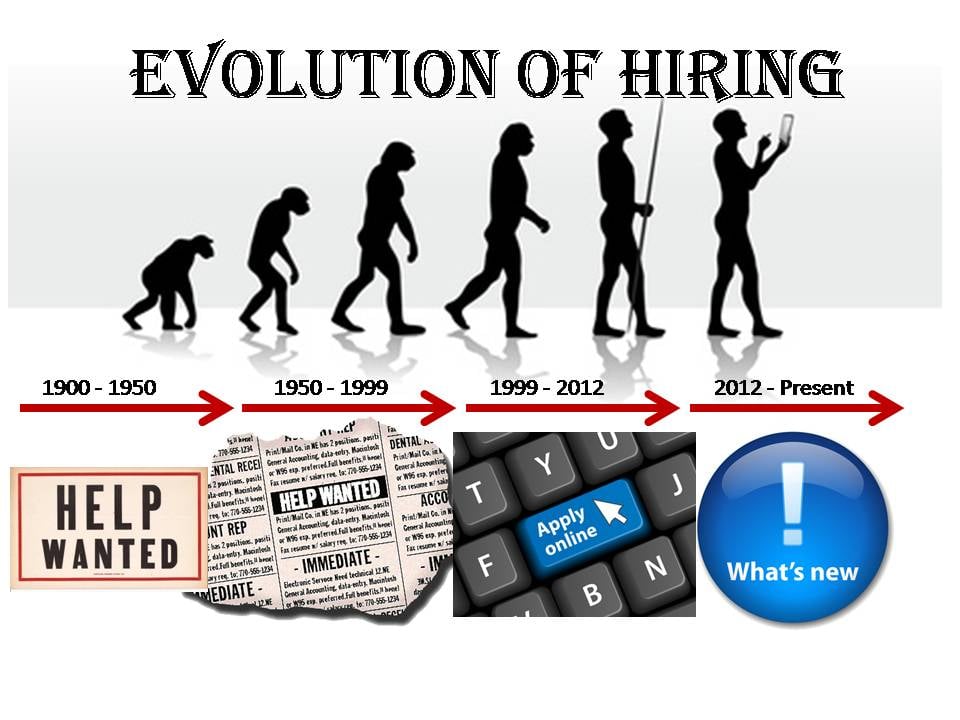The Evolution of Hiring: A Comprehensive Look at Online Job Application Systems
Related Articles: The Evolution of Hiring: A Comprehensive Look at Online Job Application Systems
Introduction
With enthusiasm, let’s navigate through the intriguing topic related to The Evolution of Hiring: A Comprehensive Look at Online Job Application Systems. Let’s weave interesting information and offer fresh perspectives to the readers.
Table of Content
The Evolution of Hiring: A Comprehensive Look at Online Job Application Systems
![How Our Job Search Has Evolved [INFOGRAPHIC]](http://blog.sparkhire.com/wp-content/uploads/2012/07/Evolution-of-Applying-for-a-Job-972w-1.png)
The landscape of job seeking and recruitment has undergone a dramatic transformation in recent decades. The advent of the internet and the subsequent rise of online platforms have revolutionized the way individuals search for employment and employers seek qualified candidates. This shift has been facilitated by the development of sophisticated online job application systems, which have streamlined the hiring process and expanded its reach to a global audience.
The Birth of Online Job Applications:
The origins of online job application systems can be traced back to the early days of the internet. In the 1990s, websites like Monster.com and CareerBuilder emerged, offering a centralized platform for job seekers to browse vacancies and submit their applications electronically. These early systems were rudimentary, often involving simple forms and limited functionality. However, they laid the foundation for the sophisticated systems that would follow.
The Rise of Applicant Tracking Systems (ATS):
The introduction of Applicant Tracking Systems (ATS) in the late 1990s marked a significant advancement in online job application technology. These systems, designed to automate the recruitment process, allow employers to manage the entire lifecycle of a job application, from initial submission to final hiring decision. ATS platforms offer features such as:
- Automated screening: ATS uses keyword matching algorithms to scan resumes and cover letters for relevant skills and experience, automatically filtering out unqualified candidates.
- Candidate database management: ATS creates and maintains a database of potential candidates, enabling employers to track their progress and easily recall them for future opportunities.
- Communication tools: ATS facilitates communication between employers and candidates, sending automated emails and notifications for application updates and interview scheduling.
- Performance tracking and analytics: ATS provides insights into the effectiveness of recruitment strategies, allowing employers to analyze key metrics and optimize their hiring processes.
The Impact of Online Job Applications:
The widespread adoption of online job application systems has brought about a fundamental shift in the recruitment landscape, impacting both job seekers and employers in numerous ways:
Benefits for Job Seekers:
- Increased accessibility: Online platforms have eliminated geographical barriers, allowing job seekers to apply for positions across the globe without the need for physical relocation.
- Enhanced efficiency: Online applications streamline the application process, allowing candidates to submit their credentials quickly and conveniently.
- Wider reach: Job seekers can access a broader range of opportunities, expanding their job search beyond local or regional limitations.
- Personalized experiences: Many platforms offer features like job alerts and personalized recommendations, tailoring the job search experience to individual preferences.
Benefits for Employers:
- Improved efficiency: ATS automates many aspects of the hiring process, reducing administrative burdens and freeing up HR professionals to focus on strategic tasks.
- Cost reduction: Online applications eliminate the need for paper-based applications and manual screening, leading to significant cost savings.
- Enhanced candidate pool: Online platforms attract a wider pool of potential candidates, increasing the likelihood of finding the ideal fit for the position.
- Data-driven decision making: ATS provides valuable data and insights into the recruitment process, enabling employers to make informed decisions based on objective metrics.
Challenges and Considerations:
Despite the numerous benefits, online job application systems also present certain challenges that need to be addressed:
- Bias in algorithms: ATS algorithms, while designed to be objective, can inadvertently perpetuate existing biases, potentially excluding qualified candidates from certain demographics.
- Digital divide: Not all job seekers have equal access to technology and internet connectivity, potentially limiting their ability to participate in the online application process.
- Over-reliance on technology: Excessive reliance on ATS can lead to a dehumanized experience for candidates, reducing the personal touch in the recruitment process.
- Security concerns: Online platforms require robust security measures to protect sensitive applicant data from unauthorized access.
Addressing the Challenges:
To mitigate these challenges and ensure a fair and inclusive hiring process, employers should consider the following:
- Human intervention: Supplementing ATS with human review ensures a more comprehensive assessment of candidates and reduces the risk of algorithmic bias.
- Accessibility initiatives: Employers should provide alternative application methods for individuals without access to technology or internet connectivity.
- Humanizing the process: Personalizing communication with candidates, offering opportunities for interaction, and fostering a positive candidate experience can counterbalance the perceived impersonality of online applications.
- Data privacy and security: Implementing robust security measures and adhering to data privacy regulations are essential to protect sensitive applicant information.
The Future of Online Job Applications:
The future of online job applications is likely to be characterized by further innovation and integration with emerging technologies. Key trends include:
- Artificial Intelligence (AI): AI-powered tools are increasingly being used to enhance the capabilities of ATS, improving candidate matching, automating tasks, and providing more insightful data analysis.
- Virtual Reality (VR) and Augmented Reality (AR): VR and AR technologies are being explored to create immersive recruitment experiences, allowing candidates to virtually "visit" workplaces and interact with potential colleagues.
- Social media integration: Social media platforms are increasingly being used for recruitment purposes, enabling employers to reach a wider audience and engage with potential candidates in a more interactive manner.
- Mobile-first approach: With the rise of mobile devices, online job application platforms are being optimized for mobile access, providing a seamless experience for job seekers on the go.
FAQs about Online Job Applications:
1. How do I apply for a job online?
- Browse job boards: Websites like Indeed, LinkedIn, Glassdoor, and Monster.com list a wide range of job openings.
- Visit company websites: Many companies post job openings directly on their websites.
- Network: Connect with people in your field and leverage your professional network to uncover hidden job opportunities.
- Follow industry-specific platforms: Websites like Stack Overflow (for tech professionals) or Healthcare Jobs (for healthcare workers) cater to specific industries.
2. What are the common elements of an online job application?
- Contact information: Your name, email address, phone number, and relevant social media links.
- Resume: A summary of your professional experience, skills, and education.
- Cover letter: A personalized letter addressing the specific job requirements and highlighting your qualifications.
- Online forms: Many platforms require you to fill out online forms with additional details about your experience and interests.
3. What is the role of an Applicant Tracking System (ATS)?
- Automated screening: ATS uses algorithms to scan resumes and cover letters for keywords, filtering out candidates who don’t meet the minimum requirements.
- Candidate database management: ATS creates and manages a database of potential candidates, allowing employers to track their progress and easily recall them for future opportunities.
- Communication tools: ATS facilitates communication between employers and candidates, sending automated emails and notifications for application updates and interview scheduling.
- Performance tracking and analytics: ATS provides insights into the effectiveness of recruitment strategies, enabling employers to analyze key metrics and optimize their hiring processes.
4. How can I optimize my online job application?
- Tailor your resume and cover letter: Customize your application materials to match the specific requirements of each job.
- Use relevant keywords: Research the job description and incorporate relevant keywords that the ATS is likely to search for.
- Proofread carefully: Ensure your application is free of grammatical errors and typos.
- Follow instructions: Pay close attention to the application instructions and submit all required documents.
5. How can I stand out from the competition?
- Build a strong online presence: Create a professional LinkedIn profile and showcase your skills and experience.
- Network actively: Attend industry events, connect with professionals on social media, and leverage your network to uncover job opportunities.
- Highlight your unique skills and experiences: Emphasize your strengths and accomplishments that are relevant to the specific job.
- Follow up after submitting your application: Send a thank-you note to the hiring manager and express your continued interest in the position.
Tips for Applying for Jobs Online:
- Create a dedicated email address: Use a professional email address that is easy to remember and reflects your name or professional identity.
- Use a consistent resume format: Stick to a standardized resume format that is easy to read and scan, such as the chronological or functional format.
- Highlight your skills and accomplishments: Use action verbs and quantifiable metrics to showcase your achievements and skills.
- Proofread carefully: Before submitting your application, carefully proofread all documents for any errors in grammar, spelling, or punctuation.
- Follow up with the hiring manager: Send a thank-you email after submitting your application and express your continued interest in the position.
Conclusion:
Online job application systems have revolutionized the recruitment process, offering numerous benefits for both job seekers and employers. While challenges exist, such as algorithmic bias and the digital divide, ongoing innovation and efforts to ensure fairness and inclusivity are addressing these concerns. As technology continues to evolve, the future of online job applications promises even more streamlined and efficient recruitment experiences, further transforming the way we find and fill jobs in the digital age.


![How Our Job Search Has Evolved [INFOGRAPHIC]](https://blog.sparkhire.com/wp-content/uploads/2012/07/Evolution-of-Applying-for-a-Job-972w-1-150x150.png)

/tice-news-prod/media/media_files/9wsijTXl7PT02H8HKAjj.jpg)


Closure
Thus, we hope this article has provided valuable insights into The Evolution of Hiring: A Comprehensive Look at Online Job Application Systems. We hope you find this article informative and beneficial. See you in our next article!
